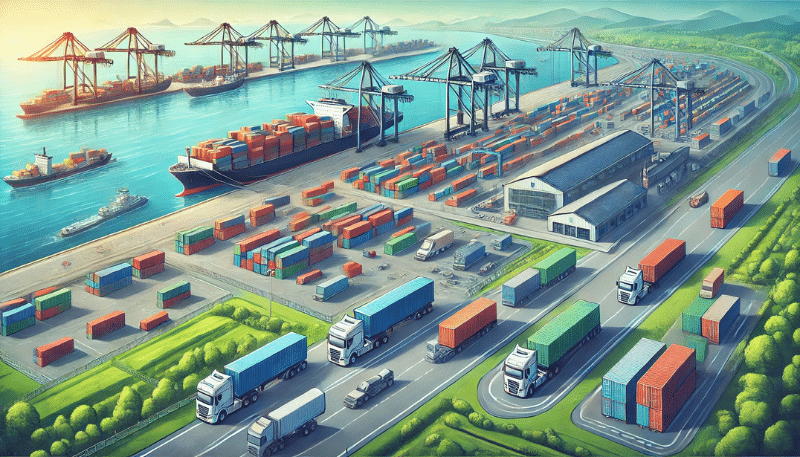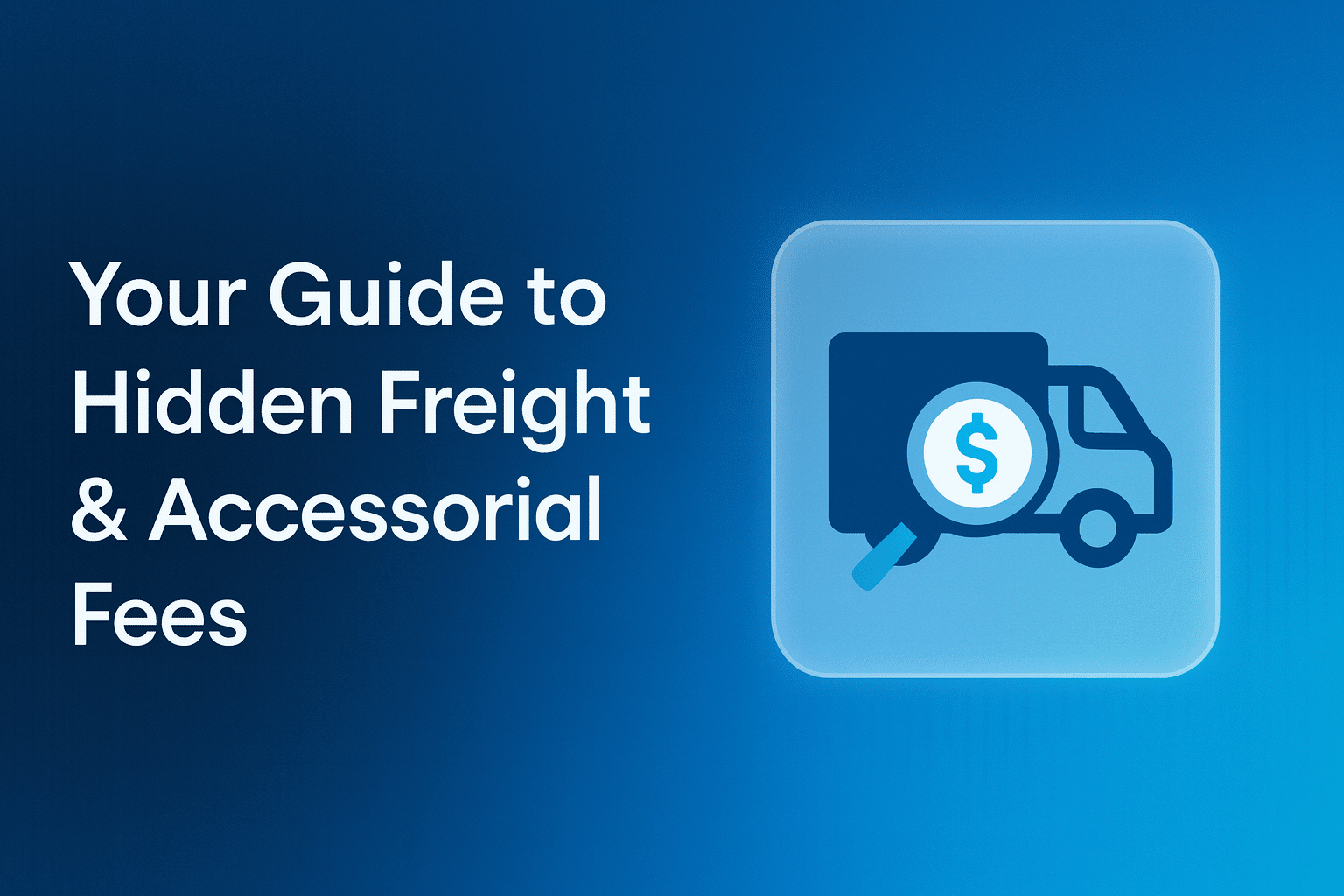Freight Fees Explained: How to Reduce Common Charges
Freight fees are the collection of charges incurred when transporting goods, encompassing everything beyond the base transportation rate. These costs include a variety of surcharges and accessorials for fuel price fluctuations, special handling, customs clearance, and more. Understanding this breakdown is the first step toward managing and reducing your overall shipping expenses.
Because freight fees significantly impact your supply chain efficiency and budget, it’s crucial to understand what your shipments may incur. This ensures you’re not overpaying and empowers you to take steps to lower your total freight costs. In this piece, we’ll highlight some of the most common fees and offer tips on reducing them.
Key Takeaways
- Freight fees encompass various charges related to transporting goods, significantly impacting shipping costs and supply chain efficiency.
- Key factors influencing freight fees include shipment weight, distance, mode of transportation, and additional fees like customs clearance and terminal handling.
- Businesses can reduce freight shipping costs through strategies such as optimizing packaging, negotiating with carriers, and leveraging freight forwarders for better rates and efficiency.
What Are Freight Fees?
Freight fees are the total costs associated with transporting goods from one location to another. They encompass a range of charges, from the basic cost of moving goods to additional fees for special handling, customs clearance, and more.
Each carrier may have its own freight rates and fees for various services, which often depend on the terms of your carrier contract. In many cases, you’ll receive a freight quote that outlines these costs based on your shipment information, making accurate details important for estimating and budgeting. After the carrier completes your shipment, they’ll include all freight fees and total costs in a freight bill, which you can then audit to verify charges and contest any errors.
A Breakdown of Common Freight Fees
Freight fees encompass a wide range of conditions and factors. Some may appear in most or all freight bills you receive, while others only apply to out-of-the-way or complex shipments. Regardless of your industry, you should be aware of these common fees to budget appropriately.
| Fee Type | Description |
| Fuel Surcharge | An adjustable fee added to account for fluctuating fuel costs, typically calculated as a percentage of the base freight rate. |
| Booking Fees | For reserving space with carriers, ensuring your shipment is secured on the desired vessel or vehicle. |
| Handling Charges | Covering the processing, loading, and unloading of goods at warehouses or terminals. |
| Documentation Fees | For preparing, managing, and submitting necessary shipping documents like bills of lading and customs paperwork. |
| Accessorial Charges | Extra fees for services like liftgate delivery or residential delivery. In 2025, carriers are strategically increasing these fees, with charges for oversize packages and additional handling rising by up to 30%. |
| Customs Clearance Fees | Charges for processing goods through customs. This has become a critical cost in 2025 following a major U.S. regulatory shift. The suspension of the de minimis exemption (for shipments under $800) and a new general 10% tariff mean nearly all imports now face duties and formal entry processes, significantly increasing costs and complexity. |
| Weight/Dimension Adjustment | Costs incurred when the actual weight or dimensions of a shipment differ from the declared values. |
| Demurrage Fees | Charges for exceeding the allowed free time at a terminal or port before pickup or delivery. |
| Detention Fees | Applied when a truck or container is delayed beyond the allowed time for loading or unloading. |
There are also some fees that only apply in certain circumstances or for high-risk shipments and deliveries.
Specialty or situational freight fees include:
- Peak Season Surcharge: Additional costs during high-demand periods. The 2025 peak season is longer and more costly, with carriers like FedEx implementing higher surcharges from September 29, 2025, through January 18, 2026, to manage network capacity.
- Hazmat Fees: Special charges for handling hazardous materials that require additional care and compliance measures.
- Port Congestion Fees: Imposed when ports experience delays. This fee has become a critical, widespread issue in 2025. Global port congestion reached crisis levels in June, with delays increasing by 300%. As a result, demurrage fees at major hubs now range from $75 to $300 per container, per day.
- Re-consignment Fees: Applied for rerouting or changing the delivery address after the shipment is in transit.
- Out-of-Delivery-Area Fees: Extra charges for shipments destined for remote or hard-to-reach locations.
What Key Factors Affect Your Freight Fees?
The following table summarizes the key cost drivers impacting freight fees in 2025.
| Fee / Factor | Typical Scenario (Pre-2025) | Current 2025 Impact |
| Port Congestion Fees | Situational; applied only at specific, temporarily backed-up ports. | Widespread crisis; delays are up 300% at major global hubs. |
| Demurrage Fees | Infrequent; typically avoidable with proper planning. | A common and significant cost; daily fees now range from $75 – $300 per container at congested ports. |
| Customs & Tariffs | Predictable; low-value shipments (under $800) often exempt from duty. | Highly volatile; de minimis exemption suspended and a new 10% general tariff has been introduced, increasing costs for nearly all imports. |
| Peak Season Surcharges | Applied during a defined holiday period (e.g., Nov-Dec). | Longer and more expensive; now runs from late September to mid-January with higher rates than previous years. |
| Accessorial Charges | Standard fees for extra services, with stable year-over-year rates. | Strategically increased by carriers; fees for services like oversize handling are up by as much as 30%. |
Freight fees and shipping costs can vary significantly from one shipment to the next. To accurately forecast your costs, you’ll need to consider the following factors.
- Freight Weight and Dimensions: A shipment’s weight and dimensions affect its size, the space it takes up, and whether it needs additional handling, all of which determine overall shipping costs.
- Shipping Distance: The distance a shipment travels impacts freight costs due to increased fuel consumption, labor, and other operational expenses.
- Mode of Transportation: Your chosen shipping method determines both cost and efficiency. Air shipping is generally more expensive but faster, while ocean shipping is slower but more cost-effective for bulky or heavy goods.
- Logistics Network Congestion & Market Volatility: In 2025, the primary factor is market volatility. Geopolitical risks, sudden tariff changes, and operational disruptions like port congestion have created a highly unpredictable pricing environment that requires dynamic forecasting.
How to Reduce Your Overall Freight Fees
While added fees can significantly increase your costs, you can reduce their impact with strategic planning.
Optimize Your Packaging
Optimizing packaging can lower shipping costs by reducing the weight and volume of shipments. Using lighter materials and efficient designs minimizes weight and occupied space, leading to lower freight rates.
Negotiate Directly with Carriers
Building strong relationships with carriers can lead to better freight rates. Effective contract negotiation involves comparing rates, leveraging shipping volume, and increasing lead times to help carriers manage resources efficiently.
Plan Shipments Strategically
Strategic scheduling is crucial for cost control. By planning shipments around peak logistics periods, you can avoid peak season surcharges. You should also consider consolidating shipments and using more economical shipping modes when your delivery schedule allows.
Work with A Freight Forwarder
Freight forwarders manage and streamline your logistics process to lower costs and improve efficiency. They handle transportation arrangements, customs clearance, documentation, and more. By leveraging their transaction volumes, they can often negotiate better freight rates than individual shippers.
Use a Transportation Spend Management System
Implementing a transportation spend management system (TSMS) like FreightOptics helps reduce overall shipping costs by tracking and analyzing expenses. These systems often include automated freight audits to ensure you don’t pay unnecessary fees or get overcharged. They can also uncover route and packaging optimizations to generate further savings.
At Zero Down, we’ve used FreightOptics to save clients millions by finding billing errors other auditors miss. For example, we helped a leading electronics distributor save over $100k annually by auditing their complex Air/Ocean invoices. Our audit uncovered numerous overcharges the previous auditors failed to find, and our business intelligence tools helped fix the root causes to prevent future errors.
Manage Freight Fees for Cost-Effective Shipping
Understanding and managing freight fees is critical to controlling your transportation costs. While common fees like fuel surcharges and customs are expected, strategic planning can mitigate their impact. To lower your freight costs, consider partnering with a supply chain solution provider like Zero Down. We provide tools like a TSMS to optimize shipments and use freight audits to ensure you only pay what you owe.
Reach out to Zero Down to learn more about cost-effective shipping solutions for your business.
FAQ
How are freight fees calculated?
Freight fees are calculated by starting with a base rate (determined by weight, distance, and mode of transport) and then adding various surcharges and accessorial fees. These can include fuel surcharges, handling fees, customs duties, and any charges for special services required during transit.
What is the difference between freight fees and shipping costs?
“Shipping costs” is a broad term for the total expense to move a product, which includes the base freight rate. “Freight fees” specifically refers to the additional charges and surcharges applied on top of that base rate, such as customs fees, accessorials, and fuel surcharges.
Why are my freight fees so high in 2025?
Freight fees are elevated in 2025 due to a combination of factors: significant global port congestion leading to high demurrage fees, new U.S. tariffs and the suspension of the de minimis exemption increasing customs costs, and carriers implementing higher and longer peak season surcharges to manage network strain.





